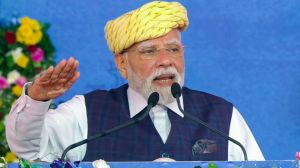Stay updated with the latest - Click here to follow us on Instagram
Journey to Vaishno Devi: On road to god, a man and his pony
The trek to Vaishno Devi shrine is now easier, safer, brighter. None of which applies to the men who have for years made their living carting pilgrims to it.
 Munshi has been ferrying pilgrims on his pony Channu since he was 14. (Express photo/Arun Sharma)
Munshi has been ferrying pilgrims on his pony Channu since he was 14. (Express photo/Arun Sharma)
Mohammad Munshi is 42 but looks 20 years older, the wrinkles on his face a sign of his difficult life and the responsibility of feeding his family of six, including three children.
On a Tuesday morning, Munshi stands near Darshani Deodi, the starting point for the 13-km trek from Katra to the Shri Mata Vaishno Devi shrine in Jammu, looking for pilgrims. Bhajans are playing on loudspeakers along the yatra route while the sound of bells from nearby temples is interspersed with pilgrims breaking into slogans of “Jai Mata Di!” and “Bol sanche darbar ki jai!”.
As they pass through metal detectors, one of several along the heavily guarded route, pausing to take selfies, Munshi anxiously approaches them, “Sahab, ghoda chahiye? Bhawan tak aaram se le jayengey 700 rupey mein (Sir, need a horse? I will take you to the shrine in comfort for Rs 700).”
As the pilgrims stall, Munshi coaxes, “Take at least till Adhkuwari. I will only charge Rs 350.”
There is hardly any response and, standing among a group of around 10-odd ponywallahs, Munshi’s face drops. It is the third consecutive day he has not found any pilgrims to ferry to the shrine. “Whether I earn or not, I need at least Rs 500-600 to buy fodder for my pony,” Munshi says.
These are uncertain days for ponywallahs like Munshi on the Vaishno Devi route. Following a plea claiming threat to environment caused by ponies and mules ferrying a growing number of pilgrims to the shrine, the National Green Tribunal had ordered a cap on the number of pilgrims per day (50,000) and said no new mules or horses would be registered.
Amidst allegations of poor upkeep of mules by their owners, the Society for Prevention of Cruelty towards Animals has additionally been given the responsibility of monitoring the equines.
Over the past three years, the number of ponies ferrying pilgrims along the route has fallen to less than half, from nearly 10,000. Apart from this, there are 5,000 “pithus” (men who carry pilgrims on their backs) and 1,500 palanquin-bearers operating on the route. While it denies that the ponies and mules would gradually be phased out, the state government is working on a policy to rehabilitate their owners.
Munshi’s father Mohammad Qasim, who died two years ago, was a “pithu”. The third of Qasim’s seven children, Munshi says he earns approximately Rs 1,400 on a good day, and more when pilgrim numbers are highest, like during the Navratras. He owns one pony, that he bought in early 2000s for Rs 65,000.
Around 1 pm, after the ponywallahs have been waiting five hours, some pilgrims approach. Munshi readily agrees as one offers Rs 700 to be taken up to the shrine.
Handing over the identity card issued by the Shri Mata Vaishnodevi Shrine Board, Munshi leaves to bring his pony from a nearby four-storey building called ‘Chetak Bhawan’. The first and second floors of the building function as stables, while the third floor is used by the ponywallas, pithus and palanquin-bearers to sleep in at night. Veterinary doctors sit on the ground floor.
The stables are dark, stinky and have plaster peeling off walls, while there is no water for the animals. The living quarters for the ponywallahs and others have no bedding or functional fans, the windows have no panes, while the floor is strewn with waste.
Returning with his pony Channu, Munshi assures the 40-year-old pilgrim a comfortable ride. The 13 kilometres to the shrine are covered in three hours, with a half-an-hour break at Adhkuwari.
As he resumes the trek, Munshi says he has been ferrying pilgrims on his pony since he was 14, except between 2006 and 2013, when he worked as a Special Police Officer (SPO) with the Jammu and Kashmir Police.
In 2006, Munshi had helped police foil a terror plan to attack devotees near the shrine, after which police appointed him as an SPO for a monthly remuneration of Rs 1,500, that was later doubled. Munshi continued in the job till the end of 2012 when his father fell ill. As he stayed away for a month, he was discharged from service. Munshi then bought a pony and resumed ferrying pilgrims to the shrine.
Since the time his father worked as a pithu, Munshi says, the volume of devotees has increased sevenfold. In 1986, about 13.96 lakh pilgrims visited Vaishno Devi. In 2017, that number stood at 82 lakh.
To accommodate the growing numbers, the Shrine Board has widened the yatra track, as well as opened an alternative route from Adhkuwari for pedestrians and battery cars. One more route, from Katra to Adhkuwari, was inaugurated by Prime Minister Narendra Modi in May this year. The area is part of the parliamentary constituency of Dr Jitendra Singh, Minister of State in the PMO.
Both the main and the alternative shrine tracks have been covered with rain shelters, are illuminated with high-pressure sodium vapour lamps, have potable water facilities and modern toilets. There are also medical centres manned by doctors round the clock.
With the amenities and tracks easing the climb, Munshi says his chances of finding customers are dwindling by the day. Now he finds customers for only 15 days a month, he says. “Earlier, I would get for 20 days.”
While ponywallahs fear they would gradually be phased out, Katra Sub-Divisional Magistrate Neelam Khajuria, who is also the nodal officer for the SPCA, denies this. “Currently, there are 4,600 ponywallas registered with the society, and no one has complained of being denied registration,” she says.
The Additional Chief Executive Officer of the Shrine Board, Anshul Garg, says mules will always remain part of the pilgrimage as they are required for transporting materials to Trikuta Hills, where the shrine is located.
Munshi though is not optimistic. His eldest son, Liquat Ali, had to drop out of school after Class 11, he says, as “I had no money for books or fees”. His two other children, Nazakat and Saida Bibi, are still in school, in Classes 9 and 8, but he is not sure for how long.
Back at Darshani Deodi by evening, the 42-year-old waits next to the shrine track till 11 pm, but no more pilgrims hire his pony. Finally deciding to call it a day, he heads to Chetak Bhawan.
Tying up his pony in the stables, he climbs up. The floor is dirtier since morning, but Munshi shrugs and lies down. “I have to be up early again.’’







